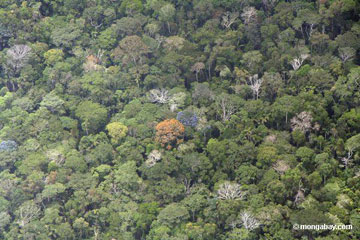Efforts to protect tropical forests under the proposed reducing emissions from deforestation and degradation (REDD) program should focus on conserving large-scale moisture gradients and areas that provide connectivity between major ecozones in order to reduce the impacts of climate change on ecosystem function and the compounding effects of deforestation, argue scientists writing in the journal Nature.
Noting that drying trends in the tropics are exacerbating fire and facilitating the destruction of forests, Jedediah Brodie of the University of Montana, Eric Post of Penn State University, and William Laurance of Australia’s James Cook University say such measures could safeguard biodiversity by creating migration corridors for plants and wildlife and protecting water cycles dependent on forests. Some research suggests forests act as giant moisture pumps that help deliver precipitation to regions that would otherwise be much drier.
 Amazon rainforest canopy in Peru. |
The authors say that while REDD is well-intentioned, it currently lacks “explicit mechanisms for increasing forest resilience”. REDD policy should focus on protecting these key forest areas as well as “[reducing] or [halting] agricultural expansion in areas of rapid deforestation, especially when such areas are also susceptible to drying, as in the Amazon’s arc of deforestation.”
“Many tropical trees are resistant to modest temperature increases and even drought. But if these changes lead people to set more fires, rainforests could be devastated,” said Brodie, the author’s lead author, in a statement. “This effect may be vastly more harmful than the impacts of climate change alone.”
“On its own, climate change could stress tropical forests, but when you add in human-lit fires and increased logging, it’s like hitting them with a sledgehammer,” he continued. “Small, isolated parks won’t be big enough to withstand these pressures. If we’re going to protect tropical biodiversity in the long term, we need to think really, really big.”
Related articles
An undamaged Amazon produces its own clouds and rain
(09/21/2010) Researchers recently traveled to the remote Brazilian Amazon to investigate how clouds are formed and rain falls in an atmosphere unburdened by human-caused pollution. Studying the atmospheric aerosol particles, which impact cloud formation and particles, above a pristine forests, researchers discovered that when left alone the Amazon acts as its own ‘bioreactor’: clouds and precipitation are produced by the abundance of plant materials.
Revolutionary new theory overturns modern meteorology with claim that forests move rain

(04/01/2009) Two Russian scientists, Victor Gorshkov and Anastassia Makarieva of the St. Petersburg Nuclear Physics, have published a revolutionary theory that turns modern meteorology on its head, positing that forests—and their capacity for condensation—are actually the main driver of winds rather than temperature. While this model has widespread implications for numerous sciences, none of them are larger than the importance of conserving forests, which are shown to be crucial to ‘pumping’ precipitation from one place to another. The theory explains, among other mysteries, why deforestation around coastal regions tends to lead to drying in the interior.